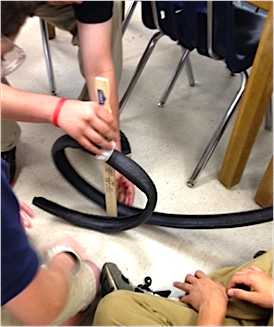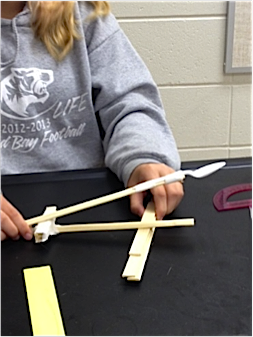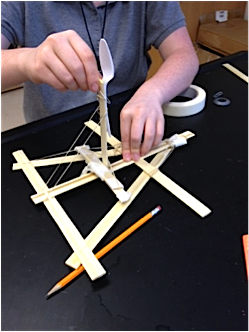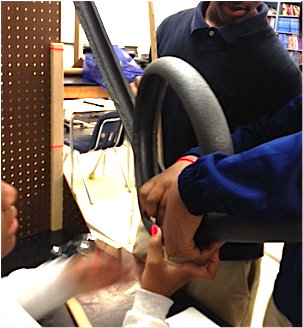Students Test Our STEM Lessons
Our teams of 8th grade science students stared at the piles of paint stirrers with expressions ranging from bafflement to careful calculation. Their challenge was to construct a catapult that would thrust a projectile onto a specific area marked on the floor. They discussed the problem, picked up the materials, shuffled them around, and finally began taping them together.
In the lab across the hall, teams of 8th grade math students were busily constructing impact barriers. They grimaced in dismay or cheered with success as they measured their barriers’ effectiveness in reducing the impact of the crashes when their model cars sped down ramps and into the barriers. Several teams suggested changes they would make in the barrier’s “stuffing” so that the barriers would absorb more shock.

Still other teams of 8th grade science students were cheering as a marble sped along the roller coaster track they had constructed – complete with loops and hills – and dropped safely into a small cup at the end of the ride. Some nearby teams found themselves adjusting the height or the hills on their coasters after their marbles went flying off the end, or stopped midway through the ride.
Giving students a role in STEM lesson development
All this experimentation took place just this past week in the Mobile public schools. Our student teams were doing important work in two ways. As STEM students, they were learning how certain science and math concepts applied to real engineering challenges. Just as important (at least from our perspective!) they were piloting some STEM lessons that might eventually be used with many other students.
The experimental lessons had first been outlined by math and science teachers working together with writers. Now they were being piloted in classrooms with student help to determine if the lessons accomplished their purpose and were clear, and if the activities worked.
In every case, as we worked through the pilot activities, the lessons were tweaked – often in significant ways – and new approaches and materials were substituted for things that didn’t pan out as expected. Now the lessons will go to the curriculum writers who will describe them in detail, format them, and run them by the lead teachers again before the final copies are distributed. These lessons will join others that are being distributed to middle school teachers system-wide to be field-implemented in classrooms next year. During the first rollout year, the lessons will be observed and adjusted again so that the final products will be as effective and polished as possible.
What doesn’t work matters!

The students also thought the lessons deserved a “thumbs up.” They gave us plenty of suggestions and feedback that we will certainly consider, such as . . .
“Give us more information about the catapults before we build them. You don’t have to show us pictures, just give us more information. And we need stronger rubber bands.”
“We don’t know why teams are using different sizes of rubber bands for our bungee cord construction. And we need to calculate the mass of the objects we are dropping ourselves.”
“We need more time on the construction part. We didn’t have time to test our roller coaster.”
“The graphs are too small to plot our data points, and we don’t have enough room on the worksheets to write.”
What students are saying about STEM
My favorite part of the week was seeing students become increasingly engaged in the STEM lessons and learning process. One student, in particular, didn’t like the STEM lessons at first. Frankly, she said, “I don’t know what to do.” But as she became more involved with her teammates, she began offering ideas, and by the end of the second day she was participating with confidence.
STEM is a growth experience for students in several different ways. I wrote down some of their comments to me as they went through the lessons.

“I really love this! But it’s so frustrating when it doesn’t work and then we have to start over again. But then it’s so cool when we figure it out.”
“I really like STEM but it’s hard. It’s really hard.”
“I like getting to try things over and over until I figure them out and they work.”
“I learn more when I can do something. I like doing real things.”
“I like hands-on. It makes what I learn in class make sense. We used Newton’s Third Law of Motion today. I mean, we really used it and saw it work. Kinetic and potential energy, too.”
“Usually no one else wants to work with me, but in here they are working with me and copying my design because it works.”
“I made a catapult and I was so proud. I love this. At first it didn’t work but I got to change it and try again and figure it out. I called my sister last night and told her about it.”
“STEM is fun. It’s challenging for me. I like trying to figure things out.”
Teamwork is too often the missing ingredient
So, it sounds as if everything went swimmingly.
Well, not quite.
One thing simply doesn’t happen naturally – teamwork. We know that from past experience, but there was no time in this experimental phase to teach students the value of working smoothly as a team, and to provide guidance for how to bring that about. So it was rough at times. And realistic, I’m sad to say.

They don’t have to start out wanting to work as a team, but if they have some guidelines built directly into the lessons on how to become a team, including checkpoints where they measure their progress, then they will have more successful experiences as teams. That has value for them, for teachers, and for the workforce they will enter.
How we help groups of students become teams of students will be the topic of future posts here. I consider teamwork to be the most underrated and undervalued part of the STEM initiative.
In the meantime, I can say that things actually went quite well with the pilot. This process is a useful and methodical approach for developing STEM lessons that all middle grades teachers can use with the knowledge that they’ve been student-tested and approved!


































Your post couldn’t have come at a better time, Anne. I just happened to be reviewing the Next Generation Science Standards (NGSS) released earlier this month and was focusing on the Science & Engineering practices for middle school. What you’ve just described coincides perfectly with MS-ETS1 (Middle School, Engineering, Technology and applications of Science) performance expectations! I applaud the teachers who worked together to help develop these lessons and pilot them. It is their hardwork and efforts that made this pilot possible, and they are truly making a difference in the teaching and learning of their students, bravo!
I couldn’t agree with you more on the importance of teamwork and collaboration in the 21st century classroom. It is a MUST! As you say, developing a working model in a classroom requires patience and time. Our students are middle schoolers and “sharing” doesn’t come naturally to them at this stage of their lives. However, speaking from experience, it is well worth the effort. I spent many years attending workshops and institutes that began with the old “cooperative learning model”, constructivist approach, and now evolved into “collaboration” to take from the best and tweak a model that works for me. What have I learned? Basically, if you take the time to establish procedures and protocols for collaboration, students will feel empowered and you will see amazing things happen socially and academically.
Thanks for the reinforcement with regard to the teamwork, Cal! I am really shaking my head over how to get the teamwork into the lessons. Without enough time to do that, a lot of the value of the STEM lessons will be lost – since teamwork is one of the most coveted workforce skills. As an aside – a lot of this STEM work does mesh quite nicely with the NGSS and the CCS, doesn’t it?
Thank you so much for sharing your experiences, as well as the student quotes! It is encouraging to see examples of STEM in action. Will these lessons eventually be accessible online or by other means? I know of teachers who would be very interested in trying some of these lessons and are hungry for more examples of how to teach STEM.
I’m glad you’re encouraged by these examples, Leslie. I also find the response of kids to STEM experiences to be encouraging. You ask a really good question about whether these lessons will be accessible online or otherwise. I certainly hope so! I’m working to write them with folks from the Engaging Youth through Engineering (EYE) project in Mobile, and with the Mobile County Public School System (MCPSS). I ran that question by them last week, and they looked thoughtful. I don’t know that it had ever occurred to them that anyone outside the MCPSS would want them. Let me work on that. If you’d like to send me your email address, just drop me a line at ajollygal2@hotmail.com. If I get a response from them soon, I’ll post it here.
Thanks again!
I love the idea of asking for student feedback. Are these or will these lessons be available for teachers? They look great, and the materials seem relatively easy to obtain. Thanks for the great post!
I am working on getting the answer to the question about making the lessons available for teachers outside the school system, Valentyna. I’d love to see that happen, since I’m an “open source” sort of person. I’ll get back with the information on this. Leslie (2 comments above yours) sent me her email address and I can get back with her when I have an answer. If you’d like to do that as well, just send me an email at ajollygal2@hotmail.com.
One of our constraints when we brainstorm and develop these particular lesson outlines is that the materials be inexpensive and easily obtainable. I personally like the idea of students working with real science equipment (beakers rather than plastic cups, for example) if it’s available to them. But realistically, if all math and science teachers in a school are conducting these lessons then there wouldn’t be enough to go around anyway. So, the inexpensive materials are the way to go.
Thanks for your comment!